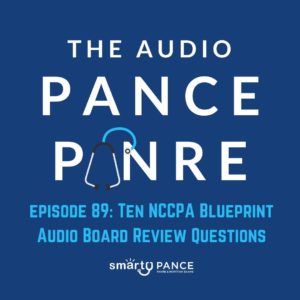Podcast: Play in new window | Download
Subscribe: Apple Podcasts | RSS

Welcome to episode 89 of the Audio PANCE and PANRE PA Board Review Podcast.
Join me as I cover ten PANCE, PANRE and EOR review questions from the Smarty PANCE Instagram/Facebook page and the smartypance.com board review website.
Special from today’s episode:
- Follow Smarty PANCE and The Daily PANCE Blueprint on Instagram
- Follow Smarty PANCE and The Daily PANCE Blueprint on Facebook
Below you will find an interactive exam to complement today’s podcast.
The Audio PANCE/PANRE and EOR PA Board Review Podcast
I hope you enjoy this free audio component to the examination portion of this site. The full board review course includes over 2,000 interactive board review questions and is available to all members of Smarty PANCE.
- You can download and listen to past FREE episodes here, on iTunes, Spotify, on Google Podcasts, Stitcher, and most podcasting apps.
- You can listen to the latest episode, take an interactive quiz, and download more resources below.
Listen Carefully Then Take the Practice Exam
If you can’t see the audio player, click here to listen to the full episode.
Podcast Episode 89: Ten PANCE/PANRE and EOR Blueprint Questions
1. The definition of amblyopia is . . .
A. Congenital cataracts noted at birth
B. Retinal detachment seen in premature children
C. Irregular pupillary size
D. Increased distance between the medial and lateral canthus
E. Subnormal visual acuity in one or both eyes despite correction of refractive error
A 45-year old woman being managed for ulcerative colitis, developed abdominal pain, vomiting, diarrhea, the passage of blood and mucus per rectum, and fever. On examination, she was pale, febrile (temp: 102.2 C), moderately dehydrated, heart rate: 124bpm. There was abdominal distention and tenderness, bowel sounds were hypoactive. Lab results showed Hb: 9g/dl, WBC: 14 x 109/L, elevated CRP. Stool was negative for C. difficile. HIV status was negative. Abdominal radiograph showed dilated transverse colon of about 11 cm. What is the most likely diagnosis of this patient?
A. Hirschsprung’s disease
B. Cytomegalovirus colitis
C. Toxic megacolon
D. Kaposi’s sarcoma
3. Which of the following is not transmitted by blood?
A. Hepatitis A
B. Hepatitis B
C. Hepatitis C
D. Hepatitis D
4. When is PKU testing performed?
A. 24 weeks gestation
B. 24 to 48 h after birth
C. 48 to 72 h after birth
D. at the first well-child visit
5. A 20-year-old female with a history of type 1 diabetes presents to the clinic complaining of weight loss, increased flatulence, foul-smelling stools, and a pruritic rash. You notice multiple papules and vesicles on the extensor surfaces of the elbows. Which of the following is most likely to be positive?
A. Anti-cyclic citrullinated peptide antibody
B. Anti-dsDNA antibody
C. Anti-tissue transglutaminase antibody
D. Anti-topoisomerase antibody
E. Anti-beta 2 glycoprotein 1antibody
6. Which of the following is the most common cause of postpartum hemorrhage?
A. Severe vaginal laceration
B. Uterine atony
C. Hematoma
D. Retained products of conception
E. Placental abruption
7. A 37-year-old female with no past medical history is brought in by EMS. She is hypotensive. On physical exam, you notice muffled heart sounds and jugular vein distention. What is the most appropriate initial treatment for this condition?
A. Emergent needle decompression
B. IV beta-blockers
C. Pericardiocentesis
D. Thrombolytics
E. None of the above
8. Which of the following should be avoided in patients who have an acute kidney injury?
A. NSAIDs
B. Aminoglycosides
C. Macrolides
D. Acetaminophen
E. Both A and B
9. A 38-year-old male presents to the ER with acute onset of dyspnea, dizziness, chest pain, and diaphoresis, He has had 4 episodes similar in the past. Vital signs are remarkable for mild tachycardia (103 bpm). Lab and imaging studies are insignificant. Which of the following is the best long-term medical treatment for the likely diagnosis?
A. Benzodiazepines
B. Selective serotonin reuptake inhibitors
C. Atypical antipsychotics
D. Calcium channel blockers
E. Melatonin
10. Which of the following best represents values you would expect in a patient with SIADH?
A. High serum sodium, high serum osmolality, low urine osmolality
B. High serum sodium, high serum osmolality, high urine osmolality
C. Low serum sodium, low serum osmolality, low urine osmolality
D. Low serum sodium, low serum osmolality, high urine osmolality
E. None of the above
Looking for all the podcast episodes?
This FREE podcast series is limited to every other episode, you can download and enjoy the complete audio series by becoming a Smarty PANCE member.
I will be releasing new episodes every few weeks. Smarty PANCE is now discounted, so sign up now before it’s too late!
Resources and Links from the Show
- Download your Free interactive PANCE, PANRE, and EOR Blueprint Templates
- Follow Smarty PANCE and The Daily PANCE Blueprint on Instagram
- Follow Smarty PANCE and The Daily PANCE Blueprint on Facebook
- My list of recommended PANCE and PANRE review books
- Sign up for the FREE Daily PANCE and PANRE email series
- Join the Smarty PANCE NCCPA Content Blueprint Website
- Get your free 8-week PANRE Blueprint study schedule and the 8-week PANCE study schedule
- Get your free Trello PANCE study planner
- Get 20% of any Picmonic membership by using this link
This Podcast is available on iOS and Android
- You can download and listen to past FREE episodes here, on iTunes, Spotify, on Google Podcasts, Stitcher, and most podcasting apps.

Download the Interactive Content Blueprint Checklist
Follow this link to download your FREE copy of the PANCE/PANRE/EOR Content Blueprint Checklists
Print it up and start crossing out the topics you understand, marking the ones you don’t, and making notes of key terms you should remember. The PDF version is interactive and linked directly to the individual lessons on Smarty PANCE.
